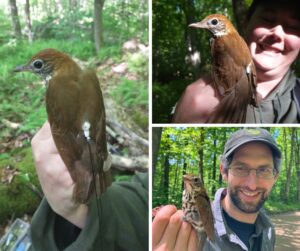(by Pam Hunt)
The flutelike “ee-o-lay” song of the Wood Thrush remains a familiar sound in hardwood forests east of the Great Plains, but over the last 50 years it has become far less common. Wood Thrush populations in the United States and Canada have declined by more than 50% since 1970, and the bird is a flagship species for concerns over the declines of migratory birds. To this end, the United States Fish and Wildlife Service (USFWS) conceived of a project to use the Motus Wildlife Tracking System to track the migratory movements of Wood Thrushes to and from their wintering areas in Mexico and Central America. The data collected will show how different breeding and wintering areas are connected and provide valuable data that can be used to conserve the species across its full annual cycle. For this project to work, the USFWS needed partners scattered across the breeding range to capture and tag thrushes, and in 2024 at least 26 states have risen to the challenge. Here in New Hampshire the project is coordinated by Dr. Pamela Hunt at NH Audubon, who has partnered with several other organizations and landowners in an attempt to deploy 25 tags by the middle of July. Institutional partners include Dr. Michael Akresh from Antioch University New England in Keene, Phil Brown of the Harris Center for Conservation Education, and Allison Byrd from the Tin Mountain Conservation Center. A final key member of the team is bird bander Lindsay Herlihy of Webster.

Wood Thrush tagging officially began on the rainy morning of May 30, when most of the team assembled in Stoddard where Harris Center scouts had previously heard multiple thrushes singing on their Granite Lake Headwaters property – which is also home to a Motus receiving tower that will pick up the tags’ signals. When the rain finally let up we were able to capture and tag our first bird, but were unsuccessful with two others nearby. The “southwest” team caught two more in nearby Nelson the next day and another three in Stoddard on June 10. Not to be outdone, Tin Mountain caught its sixth birds on June 20. With half of our transmitters now deployed, efforts are about to shift to the southeast, where NH Audubon hopes to capture birds near our centers in Concord and Auburn, as well as at the Great Bay National Wildlife Refuge and areas around Exeter. After tagged birds depart on their southward migration in September, the Motus Wildlife Tracking System will detect them as they pass within range of any towers on their route, during their stationary period on their winter grounds, and again as they return north next April. Depending on how successful banders are in the United States and Canada, there may be over 500 Wood Thrushes tagged and tracked as they pass Motus receivers this fall, the largest single species project using this system to date. And this winter, partners in Central America hope to tag another 150 Wood Thrushes to see where they go to breed.
Article cover photo: Male Wood Thrush singing at the Great Bay NWR by Pam Hunt.
